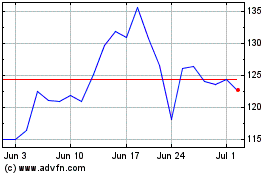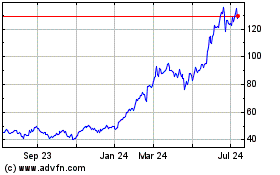NVIDIA today announced that NVIDIA Omniverse™ Cloud will be
available as APIs, extending the reach of the world’s leading
platform for creating industrial digital twin applications and
workflows across the entire ecosystem of software makers.
The five new Omniverse Cloud application
programming interfaces enable developers to easily integrate core
Omniverse technologies directly into existing design and automation
software applications for digital twins, or their simulation
workflows for testing and validating autonomous machines like
robots or self-driving vehicles.
Some of the world’s largest industrial software
makers that are embracing Omniverse Cloud APIs into their software
portfolios include: Ansys, Cadence, Dassault Systèmes for its
3DEXCITE brand, Hexagon, Microsoft, Rockwell Automation, Siemens
and Trimble.
“Everything manufactured will have digital twins,”
said Jensen Huang, founder and CEO of NVIDIA. “Omniverse is the
operating system for building and operating physically realistic
digital twins. Omniverse and generative AI are the foundational
technologies to digitalize the $50 trillion heavy industries
market.”
New Omniverse Cloud APIs The five
new Omniverse Cloud APIs, which can be used individually or
collectively, include:
- USD Render — generates fully ray-traced NVIDIA
RTX™ renders of OpenUSD data.
- USD Write — lets users modify and interact
with OpenUSD data.
- USD Query — enables scene queries and
interactive scenarios.
- USD Notify — tracks USD changes and provides
updates.
- Omniverse Channel — connects users, tools and
worlds to enable collaboration across scenes.
Bringing Interactive Visualization and
Collaboration to Industrial ApplicationsSiemens, a leading
technology company for automation, digitalization and
sustainability, is adopting Omniverse Cloud APIs within its Siemens
Xcelerator Platform, starting with Teamcenter X, the
industry-leading cloud-based product lifecycle management (PLM)
software.
In his GTC keynote, Huang showed Teamcenter X
connected to Omniverse APIs, giving the software the ability to
connect design data to NVIDIA generative AI APIs, and use Omniverse
RTX rendering directly inside the app.
“Through the NVIDIA Omniverse API, Siemens empowers
customers with generative AI to make their physics-based digital
twins even more immersive,” said Roland Busch, president and CEO of
Siemens AG. “This will help everybody to design, build and test
next-generation products, manufacturing processes and factories
virtually before they are built in the physical world. By combining
the real and the digital worlds, Siemens digital twin technology is
enabling companies around the world to become more competitive,
resilient and sustainable.”
Ansys, a leader in engineering-simulation software,
is adopting Omniverse Cloud APIs to enable data interoperability
and RTX visualization in solutions such as Ansys AVxcelerate™ for
autonomous vehicles, Ansys Perceive EM for 6G simulation, and
NVIDIA accelerated solvers such as Ansys Fluent™.
Cadence, a leading computational software provider,
is adopting Omniverse Cloud APIs into its Cadence® Reality Digital
Twin Platform so enterprises can design, simulate and optimize data
centers in a digital twin prior to physical build-out.
Dassault Systèmes, a leader in virtual universes
for sustainable innovation, is adopting Omniverse Cloud APIs and
Shutterstock 3D AI Services to power generative storytelling in its
3DEXCITE applications for content creation.
Other examples include:
- Construction and geospatial technology leader Trimble plans to
leverage the APIs to enable the use of interactive NVIDIA Omniverse
RTX viewers with Trimble model data.
- Hexagon, the global leader in reality technology, will
integrate its reality capture sensors and digital reality platforms
with the NVIDIA Omniverse Cloud APIs through USD interoperability,
empowering customers with hyper-realistic simulation and
visualization capabilities.
- Industrial-automation and digital transformation company
Rockwell Automation will use Omniverse Cloud APIs to power
RTX-enabled visualization.
In a demo released at GTC, Microsoft and NVIDIA
reveal early work with Hexagon and Rockwell Automation that
showcases these advancements.
Accelerating Autonomous Machine
DevelopmentAs demand increases for robots, autonomous
vehicles (AVs) and AI-based monitoring systems, developers are
seeking to accelerate their end-to-end workflows.
Sensor data is critical for training, testing and
validating full-stack autonomy, from perception to planning and
control.
Omniverse Cloud APIs connect a rich developer
ecosystem of simulation tools and applications — such as
Foretellix’s Foretify™ Platform, CARLA, MathWorks — and
industry-leading sensor solution providers like FORVIA HELLA,
Luminar, SICK AG and Sony Semiconductor Solutions to enable
full-stack training and testing with high-fidelity, physically
based sensor simulation.
Available first on Microsoft Azure, Omniverse Cloud
APIs will be offered later this year for developers to self-host on
NVIDIA A10 GPUs or as managed services on NVIDIA OVX™.
“The next era of industrial digitalization has
arrived,” said Andy Pratt, corporate vice president, Microsoft
Emerging Technologies. “With NVIDIA Omniverse APIs on Microsoft
Azure, organizations across industries and around the world can
connect, collaborate and enhance their existing tools to create the
next wave of AI-enabled digital twins.”
Transforming Industries With Omniverse
Digital TwinsThe new cloud APIs complement the broad
adoption of Omniverse by a range of global leaders across
industries, including:
- WPP, the world's largest marketing and communications services
company, announced a further phase of its Omniverse Cloud-based
generative AI content generation engine, bringing the AI-driven
solution to the retail and consumer packaged goods sector.
- Media.Monks announced the adoption of Omniverse to build a
generative AI and OpenUSD-enabled content creation pipeline to
unlock scale and hyper-personalization across any customer
journey.
- Continental, a major automotive supplier, is developing a
digital twin platform to optimize its factory operations and
accelerate its time-to-market.
To learn more about NVIDIA Omniverse, watch the GTC
keynote. Register free to attend Omniverse sessions from NVIDIA and
industry leaders at GTC, which runs through March 21.
About NVIDIASince its founding in
1993, NVIDIA (NASDAQ: NVDA) has been a pioneer in accelerated
computing. The company’s invention of the GPU in 1999 sparked the
growth of the PC gaming market, redefined computer graphics,
ignited the era of modern AI and is fueling industrial
digitalization across markets. NVIDIA is now a full-stack computing
infrastructure company with data-center-scale offerings that are
reshaping industry. More information at
https://nvidianews.nvidia.com/.
For further information,
contact:Kasia JohnstonNVIDIA
Corporation+1-415-813-8859kasiaj@nvidia.com
Certain statements in this press release including,
but not limited to, statements as to: the benefits, impact,
performance, features, and availability of NVIDIA’s products and
technologies, including Omniverse Cloud APIs including USD Render,
USD Write, USD Query, USD Notify, and Omniverse Channel, NVIDIA A10
GPUs, and NVIDIA OVX; everything manufactured having digital twins;
Omniverse being the operating system for building and operating
physically realistic digital twins; Omniverse and generative AI
being the foundational technologies to digitalize the $50 trillion
heavy industries market; third parties’ adoption or use of our
products or technologies, and the benefits and impacts thereof; and
with NVIDIA Omniverse APIs on Microsoft Azure, organizations across
industries and around the world being able to connect, collaborate,
and enhance their existing tools to create the next wave of
AI-enabled digital twins are forward-looking statements that are
subject to risks and uncertainties that could cause results to be
materially different than expectations. Important factors that
could cause actual results to differ materially include: global
economic conditions; our reliance on third parties to manufacture,
assemble, package and test our products; the impact of
technological development and competition; development of new
products and technologies or enhancements to our existing product
and technologies; market acceptance of our products or our
partners' products; design, manufacturing or software defects;
changes in consumer preferences or demands; changes in industry
standards and interfaces; unexpected loss of performance of our
products or technologies when integrated into systems; as well as
other factors detailed from time to time in the most recent reports
NVIDIA files with the Securities and Exchange Commission, or SEC,
including, but not limited to, its annual report on Form 10-K and
quarterly reports on Form 10-Q. Copies of reports filed with the
SEC are posted on the company's website and are available from
NVIDIA without charge. These forward-looking statements are not
guarantees of future performance and speak only as of the date
hereof, and, except as required by law, NVIDIA disclaims any
obligation to update these forward-looking statements to reflect
future events or circumstances.
Many of the products and features described herein
remain in various stages and will be offered on a
when-and-if-available basis. The statements above are not intended
to be, and should not be interpreted as a commitment, promise, or
legal obligation, and the development, release, and timing of any
features or functionalities described for our products is subject
to change and remains at the sole discretion of NVIDIA. NVIDIA will
have no liability for failure to deliver or delay in the delivery
of any of the products, features or functions set forth herein.
© 2024 NVIDIA Corporation. All rights reserved.
NVIDIA, the NVIDIA logo, NVIDIA Omniverse, NVIDIA OVX, and NVIDIA
RTX are trademarks and/or registered trademarks of NVIDIA
Corporation in the U.S. and other countries. Other company and
product names may be trademarks of the respective companies with
which they are associated. Features, pricing, availability and
specifications are subject to change without notice.
A photo accompanying this announcement is available at
https://www.globenewswire.com/NewsRoom/AttachmentNg/226268a6-9045-4fbe-ae92-ddb73a95c5d1
NVIDIA (NASDAQ:NVDA)
Historical Stock Chart
From Mar 2024 to Apr 2024

NVIDIA (NASDAQ:NVDA)
Historical Stock Chart
From Apr 2023 to Apr 2024
